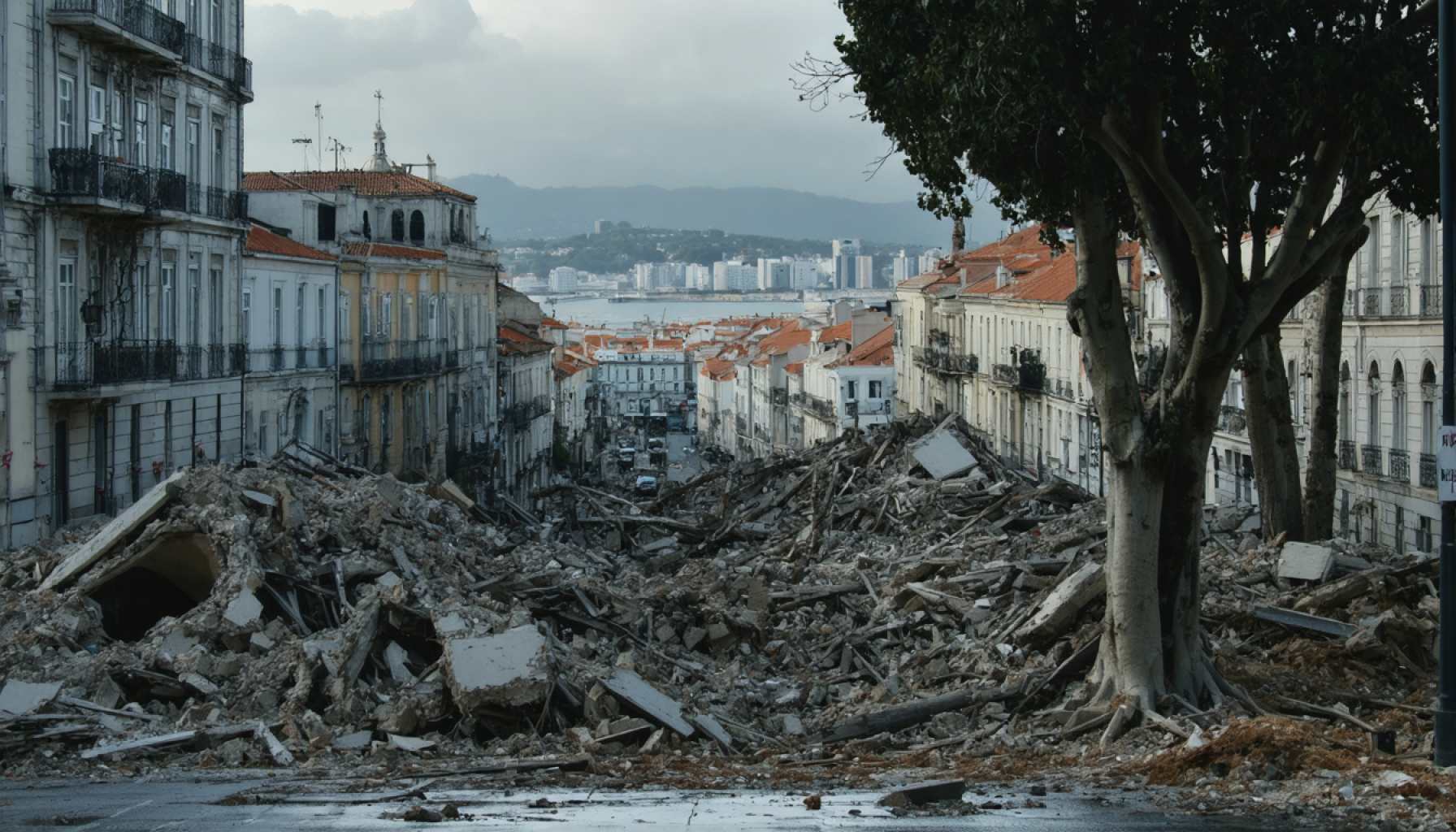- A magnitude 4.8 earthquake strikes the suburb of Charneca de Caparica, just south of Lisbon, catching the attention of the U.S. Geological Survey.
- Residents across Lisbon experience the tremor, creating a mix of anxiety and curiosity as the seismic activity permeates the city.
- The Portuguese Institute for Sea and Atmosphere remains silent, leaving citizens in an information void as they seek clarity and updates.
- Seismic experts confirm the earthquake’s source but offer limited details, adding to the city’s intrigue and concern.
- The event highlights Lisbon’s vulnerability to natural events and underscores the importance of preparedness and resilience in the face of uncertainty.
- Amidst the concern, an unspoken camaraderie emerges among residents, all facing nature’s unpredictable forces together.
A sudden tremor reverberates through Lisbon’s metropolitan sprawl, emanating like a whispered secret from the quiet suburb of Charneca de Caparica. The ground quivers with a magnitude of 4.8, as noted by the vigilant eyes of the U.S. Geological Survey. Just south of Portugal’s bustling capital, this small community unwittingly becomes the focal point of seismic activity.
Residents across the city carry on with their day, many startled by the unsettling, brief dance of the earth beneath them. The rumble spreads, its reach extending tentacle-like through the dense urban landscape, leaving conversations in its wake, filled with anxiety and curiosity.
Yet, when glancing at the official channels for clarity, citizens find themselves in an informational void. The Portuguese Institute for Sea and Atmosphere, a typical go-to for such updates, remains silent, its digital window shuttered against the increasing demand for answers. Meanwhile, seismic experts agree on the source, but details remain sparse, amplifying Lisbon’s intrigue.
Across the Tagus River, from Alto do Pina to Chiado, there is an unspoken camaraderie as strangers share knowing nods—an acknowledgement of nature’s unpredictable choreography. Though the tremor was brief, it serves as a poignant reminder of our planet’s restless energy and the fragility underpinning our daily routines.
As the dust settles and updates trickle in, the pressing conversation pivots to preparedness and resilience. Lisbon, a city built on tales and history, adds another chapter—a tremor felt, questions posed, and a poised community ready for whatever follows.
Is Lisbon Ready for The Next Big Quake? Here’s What You Need to Know
How-To Steps & Life Hacks: Preparing for Future Earthquakes
1. Create an Emergency Kit: Assemble a kit that includes water, non-perishable food, a flashlight, batteries, a first-aid kit, and essential medications.
2. Develop a Family Emergency Plan: Make sure every family member knows what to do and where to meet when a quake strikes.
3. Secure Heavy Furnishings: Anchor bookshelves, cabinets, and other heavy furniture to walls to prevent tipping during a tremor.
4. Know Safe Spots: Identify sturdy furniture or structural points in your home under which you can take cover during a quake.
5. Conduct Regular Drills: Practice earthquake safety drills to ensure everyone knows the drop, cover, and hold on technique.
Real-World Use Cases
– Urban Planning and Reconstruction: Cities like San Francisco have implemented strict building codes that Lisbon could model to improve resilience against earthquakes.
– Seismic Early Warning Systems: Countries like Japan have advanced warning systems that can notify citizens seconds before shaking starts, allowing for critical preparation time.
Market Forecasts & Industry Trends
According to a report by MarketsandMarkets, the seismic survey market is poised to grow significantly, driven by increasing need for disaster management and early warning systems. Lisbon might benefit from investing in these technologies to improve its seismic preparedness.
Reviews & Comparisons
– Seismic Sensors: Compare the capabilities of various sensors used for early detection, such as MEMS accelerometers and broadband seismometers.
– Building Materials: Evaluate different materials for earthquake-resistant construction, such as reinforced concrete and flexible steel frameworks.
Controversies & Limitations
A debate exists on the adequacy of Lisbon’s current building regulations concerning seismic activity. Critics argue that many structures, particularly historical ones, don’t meet modern safety standards, posing a threat in the event of a stronger earthquake.
Features, Specs & Pricing
Investing in systems like ShakeAlert or EEW could provide Lisbon residents with critical seconds of warning. These systems use a network of sensors to detect seismic waves and cost between €10,000 to €50,000 for large-scale municipal implementations.
Security & Sustainability
Ensuring seismic resilience also means considering long-term sustainability. Retrofitting buildings, while initially costly, can reduce future disaster recovery expenses and enhance urban sustainability by prolonging structure lifespans.
Insights & Predictions
Experts predict that the likelihood of a major quake affecting Lisbon within the next 50 years is significant. Proactive measures in urban planning and infrastructure investments are essential to mitigate potential damages.
Tutorials & Compatibility
For DIY enthusiasts, online tutorials can guide through securing home furniture and creating emergency kits. Various mobile apps are compatible with Android and iOS for receiving seismic alerts, such as QuakeFeed and Earthquake Network.
Pros & Cons Overview
Pros:
– Improved preparedness can drastically reduce casualties and economic loss.
– Investing in technology like early warning systems enhances safety.
Cons:
– Initial investment for infrastructure upgrades can be considerable.
– Implementing new building codes can be disruptive for ongoing constructions.
Actionable Recommendations
– Immediate Action: Conduct a personal home inspection to identify and mitigate hazards.
– Community Engagement: Advocate for local government investment in early warning systems and updated building codes.
– Stay Informed: Follow trusted sources for regular updates and information on seismic activities.
By implementing these measures, Lisbon can enhance its resilience to future seismic events, safeguarding both lives and the city’s rich cultural heritage for generations to come.
For more information on earthquake preparedness, visit the CDC and Red Cross websites.
